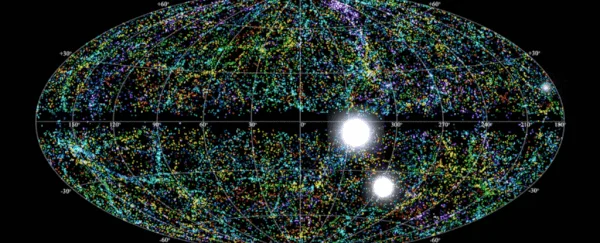
An enigmatic cosmic signal has recently been detected exhibiting a behavior unprecedented in our observations.
Amidst the repetition of a fast radio burst, scientists have observed a decline in the central frequency of the signals over time – a descent likened to a cosmic slide-whistle when slowed and played on a xylophone.
The significance of this distinctive decrease in frequency remains uncertain for now – except for the persistent peculiarity of fast radio bursts, which continue to defy straightforward explanations.
“This work is exciting because it provides both confirmation of known FRB properties and the discovery of some new ones,” says of the SETI Institute.
“We’re narrowing down the source of FRBs, for example, to extreme objects such as magnetars, but no existing model can explain all of the properties that have been observed so far.”
Fast radio bursts, or FRBs, are exceptionally peculiar yet remarkably intriguing. True to their name, these are brief bursts of radio emission, spanning from just a few microseconds to seconds.
These bursts are incredibly potent, releasing in that brief timeframe an amount of energy equivalent to 500 million Suns. Catching them is a bit challenging: the majority of FRBs have only been captured flaring once, manifesting as an unusual and unpredictable spike in radio survey data.
Their unpredictable nature and lack of repetition have posed challenges in their study (though not insurmountable – significant progress has been achieved in tracking and analyzing these singular signals).
However, a few FRB sources exhibit a unique behavior: they recur repeatedly, producing an unusual staccato burst of signals that sometimes adheres to a pattern, and at other times, does not.
These recurring sources provide a chance to pinpoint the origin of an FRB with exceptional precision and to systematically plan for and scrutinize signals from a singular source.
Sheikh and her team have undertaken this task by focusing on a source identified as FRB 20220912A, originating from a distant galaxy approximately one billion light-years away.
They examined 541 hours of observational data from the Allen Telescope Array, identifying a total of 35 bursts, each lasting an average of 1.2 milliseconds.
Subsequently, they elongated these signals and examined the evolution of the emission from the source. Certain traits were observed in the bursts of FRB 20220912A that aligned with characteristics found in other FRBs, including a descending frequency shift, a correlation between signal bandwidth and center frequency, and variations in burst duration over time.
The investigators searched for trends in the transmission of the bursts and discovered none. FRB 20220912A seems to be one of the repeaters that randomly emits signals. Nevertheless, the emitted signals are quite intriguing.
Throughout the two months when the bursts occurred sporadically, the scientists also observed a decline in the center frequency of the bursts. Listen to what this sounds like when the data is converted into musical notes on a xylophone.
The reason behind this decline is still unknown, but uncovering this information could assist scientists in determining the origins of FRBs.
Indications suggest that at least some FRBs originate from magnetars, but it remains uncertain if this applies to all FRBs or if diverse magnetar behaviors underlie different types of FRBs. Despite progressing toward answers, we are still far from a comprehensive understanding of the processes that generate these signals.
Discovering unusual behaviors brings us nearer, even if we haven’t fully comprehended them yet. The behaviors observed in FRB 20220912A neither support nor dismiss any models of FRB creation and propagation. However, they do establish a reference point for future observations, according to the researchers.
This finding underscores the significance of instruments like the Allen Telescope Array, capable of capturing a broad spectrum of bandwidths while observing the sky. This capability unveils behaviors that might escape detection by instruments with a more limited focus.
“More observations of the source,” the researchers write, “especially at higher frequencies with instruments like the ATA, will help to differentiate between the various classes of FRB progenitor models.”
The team’s research paper has been accepted for publication in the Monthly Notices of the Royal Astronomical Society and is accessible on the preprint server arXiv.





